Exploring the Combustion Performance of a Non-Road Air-Cooled Two-Cylinder Turbocharged Diesel Engine
Abstract
:1. Introduction
2. Setup and Methods
2.1. Experimental Setup
2.2. Experimental Procedures and Key Parameters
2.3. Simulation Procedures and Key Parameters
3. Results and Discussion
3.1. Simulation Model Verification
3.2. Effects of Intake Air Conditions
3.3. Effects of Combustion Chamber Shape
3.4. Effects of Compression Ratio
3.5. Effects of Injection Timing
4. Conclusions
Author Contributions
Funding
Institutional Review Board Statement
Informed Consent Statement
Data Availability Statement
Conflicts of Interest
References
- Shi, X.C.; Liu, B.L.; Zhang, C.; Hu, J.C.; Zeng, Q.Q. A study on combined effect of high EGR rate and biodiesel on combustion and emission performance of a diesel engine. Appl. Therm. Eng. 2017, 125, 1272–1279. [Google Scholar] [CrossRef]
- Feng, R.; Chen, K.; Sun, Z.W.; Hu, X.L.; Li, G.H.; Wang, S. A comparative study on the energy flow of a hybrid heavy truck between AMT and MT shift mode under local driving test cycle. Energy Convers. Manag. 2022, 256, 115359. [Google Scholar] [CrossRef]
- Singh, B.; Niwas, R. Fuel-efficient Induction Generator Based Diesel Generator Set for Stand-alone Supply Systems. Electr. Power Compon. Syst. 2015, 43, 2019–2028. [Google Scholar] [CrossRef]
- Marqusee, J.; Don, D.J., II. Reliability of emergency and standby diesel generators: Impact on energy resiliency solutions. Appl. Energy 2020, 268, 114918. [Google Scholar] [CrossRef]
- Knudsen, J.; Bendtsen, J.D.; Andersen, P.; Madsen, K.K.; Sterregaard, C.H. Supervisory control implementation on diesel-driven generator sets. IEEE Trans. Ind. Electron. 2018, 65, 9698–9705. [Google Scholar] [CrossRef]
- Wu, Q.; Liang, X.; Zhu, Z.; Cui, L.; Liu, T. Numerical Simulation Research on Combustion and Emission Characteristics of Diesel/Ammonia Dual-Fuel Low-Speed Marine Engine. Energies 2024, 17, 2960. [Google Scholar] [CrossRef]
- Visan, N.A.; Niculescu, D.C.; Ionescu, R.; Dahlin, E.; Eriksson, M.; Chiriac, R. Study of Effects on Performances and Emissions of a Large Marine Diesel Engine Partially Fuelled with Biodiesel B20 and Methanol. J. Mar. Sci. Eng. 2024, 12, 952. [Google Scholar] [CrossRef]
- Ding, Y.; Sui, C.; Li, J. An experimental investigation into combustion fitting in a direct injection marine diesel engine. Appl. Sci. 2018, 8, 2489. [Google Scholar] [CrossRef]
- Saad, S.M.; Mishra, R. Performance of a heavy-duty turbocharged diesel engine under the effect of air injection at intake manifold during transient operations. Arab. J. Sci. Eng. 2019, 44, 5863–5875. [Google Scholar] [CrossRef]
- Carlucci, A.P.; Ficarella, A.; Trullo, G. Performance optimization of a two-stroke supercharged diesel engine for aircraft propulsion. Energy Convers. Manag. 2016, 122, 279–289. [Google Scholar] [CrossRef]
- Taghavifar, H.; Nemati, A.; Salvador, F.; De la Morena, J. 1D energy, exergy, and performance assessment of turbocharged diesel/hydrogen RCCI engine at different levels of diesel, hydrogen, compressor pressure ratio, and combustion duration. Int. J. Hydrogen Energy 2021, 46, 22180–22194. [Google Scholar] [CrossRef]
- Liu, X.; Zeng, L.; Li, X.; Chen, X.; Su, H. Thermodynamic analysis of cogeneration system with diesel engines for offshore oil production facilities under variable loads. Energy Sources Part A Recovery Util. Environ. Eff. 2020, 1–16. [Google Scholar] [CrossRef]
- Annamalai, R.; Kuppusamy, R.; Krishnan, R.S. Effect of piston bowl geometry and different injection pressure on the performance, emission and combustion characteristics of diesel engine using biodiesel blend. Therm. Sci. 2018, 22, 1445–1456. [Google Scholar] [CrossRef]
- Singh, B.; Shukla, S.K. Experimental analysis of combustion characteristics on a variable compression ratio engine fuelled with biodiesel (castor oil) and diesel blends. Biofuels 2016, 7, 471–477. [Google Scholar] [CrossRef]
- Menacer, B. The convection heat transfer rate evaluation of a 6-cylinder in-line turbocharged direct-injection diesel engine. Mechanics 2017, 23, 528–536. [Google Scholar] [CrossRef]
- Liu, C.; Liu, Z.; Tian, J.; Han, Y.; Xu, Y.; Yang, Z. Comprehensive investigation of injection parameters effect on a turbocharged diesel engine based on detailed exergy analysis. Appl. Therm. Eng. 2019, 154, 343–357. [Google Scholar] [CrossRef]
- Pehlivan, E.F.; Altin, I. Exergy analysis under consideration of operational parameters by numerical approach in a two-stroke marine diesel engine. Fuel 2024, 368, 131650. [Google Scholar] [CrossRef]
- Li, Y.; Zhang, C.; Yu, W.; Wu, H. Effects of rapid burning characteristics on the vibration of a common-rail diesel engine fueled with diesel–methanol dual-fuel. Fuel 2016, 170, 176–184. [Google Scholar] [CrossRef]
- Huang, R.; Ni, J.; Wang, Q.; Shi, X.; Yin, Q. Experimental and Mechanism Study of Aerodynamic Noise Emission Characteristics from a Turbocharger Compressor of Heavy-Duty Diesel Engine Based on Full Operating Range. Sustainability 2023, 15, 11300. [Google Scholar] [CrossRef]
- Zammit, J.-P.; McGhee, M.J.; Shayler, P.J.; Pegg, I. The influence of cylinder deactivation on the emissions and fuel economy of a four-cylinder direct-injection diesel engine. Proc. Inst. Mech. Eng. Part D J. Automob. Eng. 2014, 228, 206–217. [Google Scholar] [CrossRef]
- Wu, L.; Fu, J.; Ma, Y.; Xie, D. The Performance of an Air-Cooled Diesel Engine with a Variable Cross-Section Dual-Channel Swirl Chamber. Energies 2022, 15, 7263. [Google Scholar] [CrossRef]
- Singh, A.P.; Agarwal, A.K. Partially homogenous charge compression ignition engine development for low volatility fuels. Energy Fuels 2017, 31, 3164–3181. [Google Scholar] [CrossRef]
- Ni, P.; Xu, H.; Zhang, Z.; Zhang, X. Effect of injector nozzle parameters on fuel consumption and soot emission of two-cylinder diesel engine for vehicle. Case Stud. Therm. Eng. 2022, 34, 101981. [Google Scholar] [CrossRef]
- Ju, K.; Kim, J.; Park, J. Numerical prediction of the performance and emission of downsized two-cylinder diesel engine for range extender considering high boosting, heavy exhaust gas recirculation, and advanced injection timing. Fuel 2021, 302, 121216. [Google Scholar] [CrossRef]
- Pan, W.; Yao, C.; Han, G.; Wei, H.; Wang, Q. The impact of intake air temperature on performance and exhaust emissions of a diesel methanol dual fuel engine. Fuel 2015, 162, 101–110. [Google Scholar] [CrossRef]
- Lee, S.; Choi, W.; Kim, C.; Lee, S.; Oh, S.; Lee, J. Effects of Overall-equivalence Ratios by Varying Intake Pressures and Exhaust Gas Recirculation Rates on the Natural Gas/Diesel Dual-fuel Combustion at a High Load Condition. Int. J. Automot. Technol. 2022, 23, 149–158. [Google Scholar] [CrossRef]
- Silva, E.; Ochoa, A.; Henríquez, J. Analysis and runners length optimization of the intake manifold of a 4-cylinder spark ignition engine. Energy Convers. Manag. 2019, 188, 310–320. [Google Scholar] [CrossRef]
- Bogdanowicz, E.F.; Bittle, J.A.; Agrawal, A.K. Numerical investigation of peripheral fuel injection to increase performance in diesel engines. Fuel 2024, 371, 131895. [Google Scholar] [CrossRef]
- Lee, C.Y.; Vo, D.Q. Influence of cold-start time reduction on scooter emissions and fuel consumption over WMTC cycle. Energy 2021, 231, 120997. [Google Scholar] [CrossRef]
- Heywood, J.B. Internal Combustion Engine Fundamentals, 2nd ed.; McGraw-Hill: New York, NY, USA, 2018. [Google Scholar]
- Feng, R.; Hu, X.; Li, G.; Sun, Z.; Ye, M.; Deng, B. Exploration on the emissions and catalytic reactors interactions of a non-road diesel engine through experiment and system level simulation. Fuel 2023, 342, 127746. [Google Scholar]
- Ni, P.Y.; Wang, X.L.; Li, H. A review on regulations, current status, effects and reduction strategies of emissions for marine diesel engines. Fuel 2020, 279, 118477. [Google Scholar] [CrossRef]
- Girtler, J. A semi-Markov model of fuel combustion process in a Diesel engine. Pol. Marit. Res. 2007, 14, 58–61. [Google Scholar]
- Yang, R.; Ran, Z.; Hadlich, R.R.; Assanis, D. A Double-Wiebe Function for Reactivity Controlled Compression Ignition Combustion Using Reformate Diesel. J. Energy Resour. Technol. 2022, 144, 112301. [Google Scholar] [CrossRef]
- Yilmaz, I.T.; Gumus, M. Investigation of the effect of biogas on combustion and emissions of TBC diesel engine. Fuel 2017, 188, 69–78. [Google Scholar] [CrossRef]
- Margot, X.; Quintero, P.; Gomez-Soriano, J.; Escalona, J. Implementation of 1D–3D integrated model for thermal prediction in internal combustion engines. Appl. Therm. Eng. 2021, 194, 117034. [Google Scholar] [CrossRef]
- Meng, X.; Zhao, C.; Cui, Z.; Zhang, X.; Zhang, M.; Tian, J.; Long, W.; Bi, M. Understanding of combustion characteristics and NO generation process with pure ammonia in the pre-chamber jet-induced ignition system. Fuel 2023, 331, 125743. [Google Scholar] [CrossRef]
- Duan, X.; Xu, Z.; Sun, X.; Deng, B.; Liu, J. Effects of injection timing and EGR on combustion and emissions characteristics of the diesel engine fuelled with acetone–butanol–ethanol/diesel blend fuels. Energy 2021, 231, 121069. [Google Scholar] [CrossRef]
- Kiplimo, R.; Tomita, E.; Kawahara, N.; Yokobe, S. Effects of compression ratio and simulated EGR on combustion characteristics and exhaust emissions of a diesel PCCI engine. J. Therm. Sci. Technol. 2011, 6, 463–474. [Google Scholar] [CrossRef]
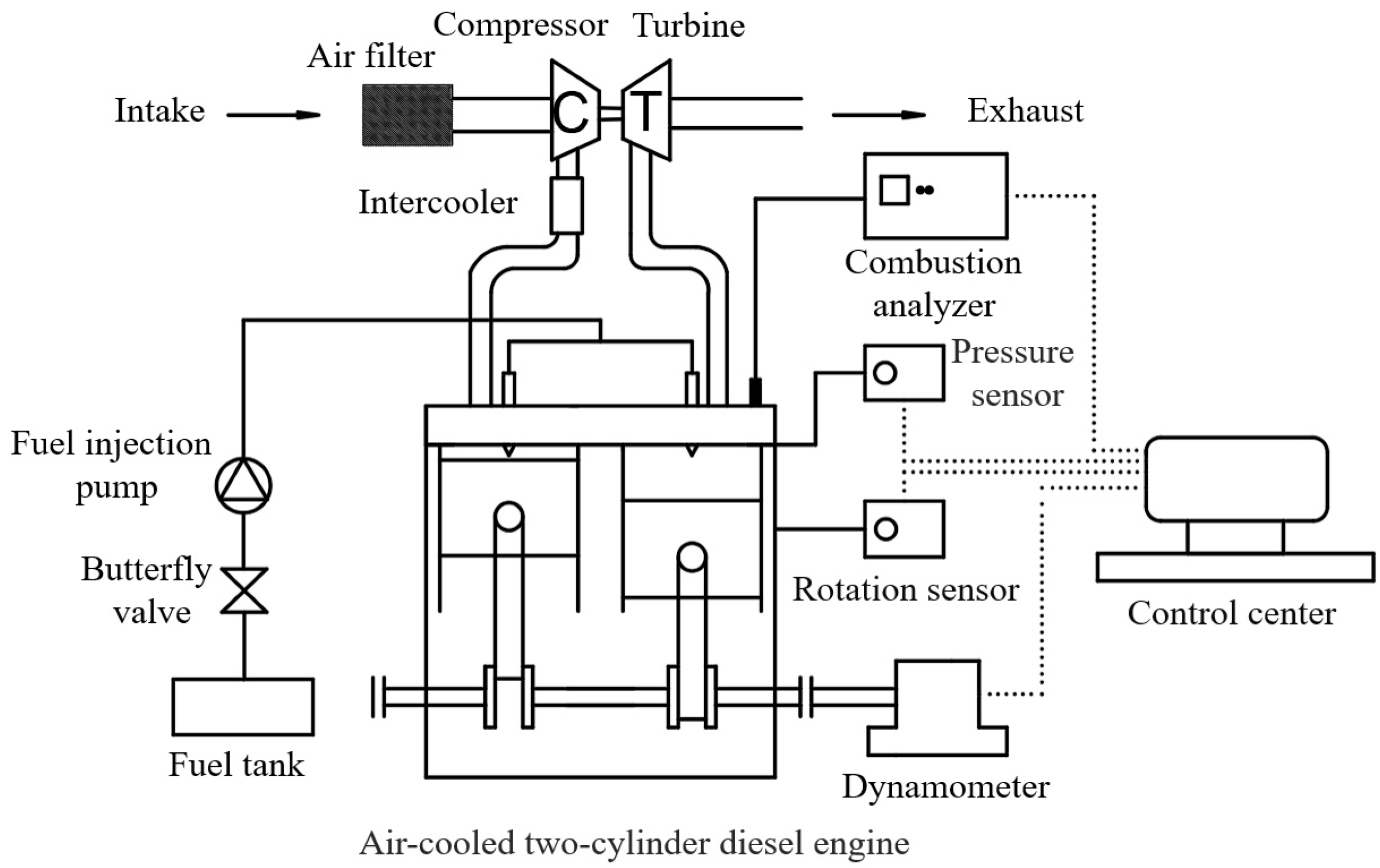
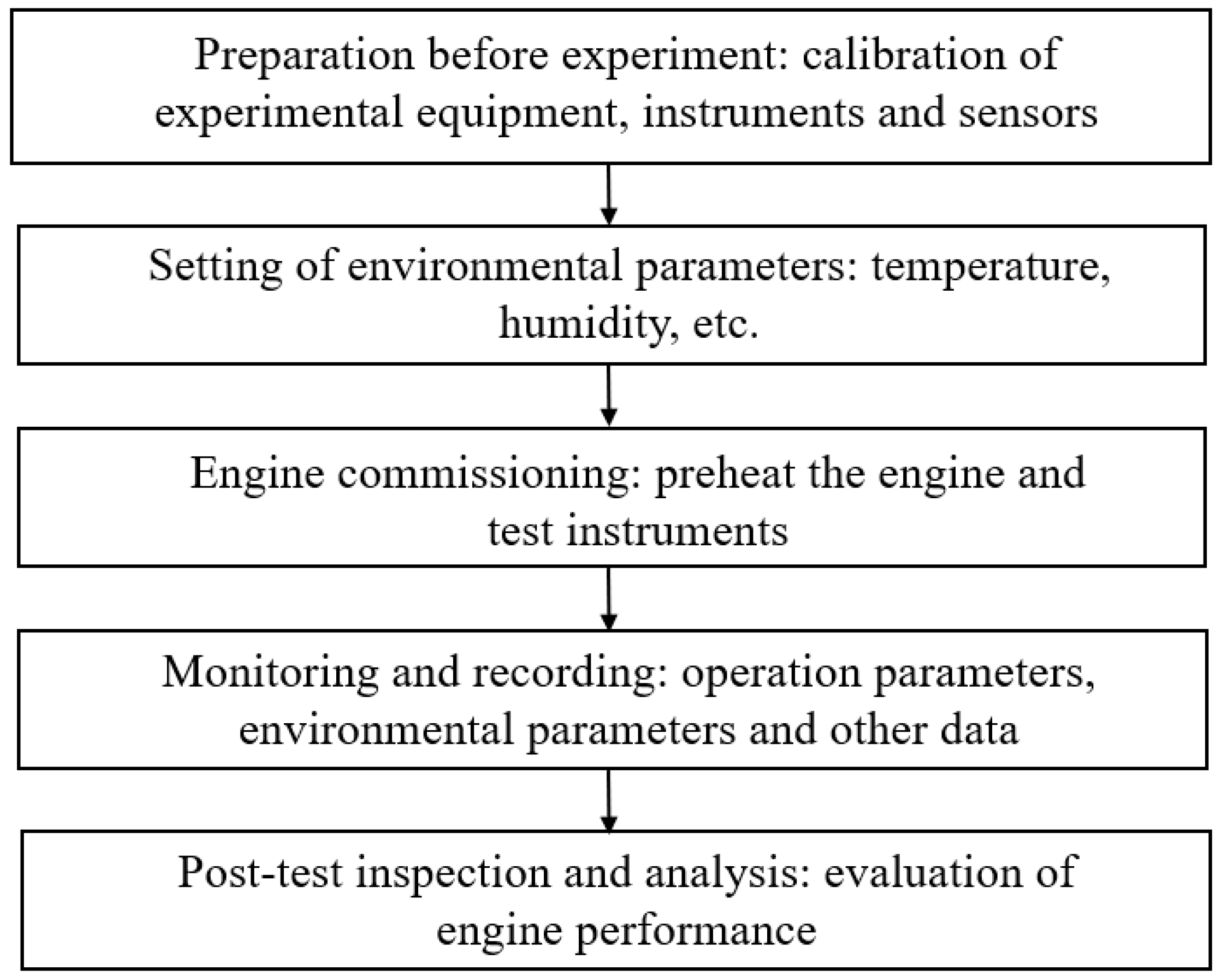
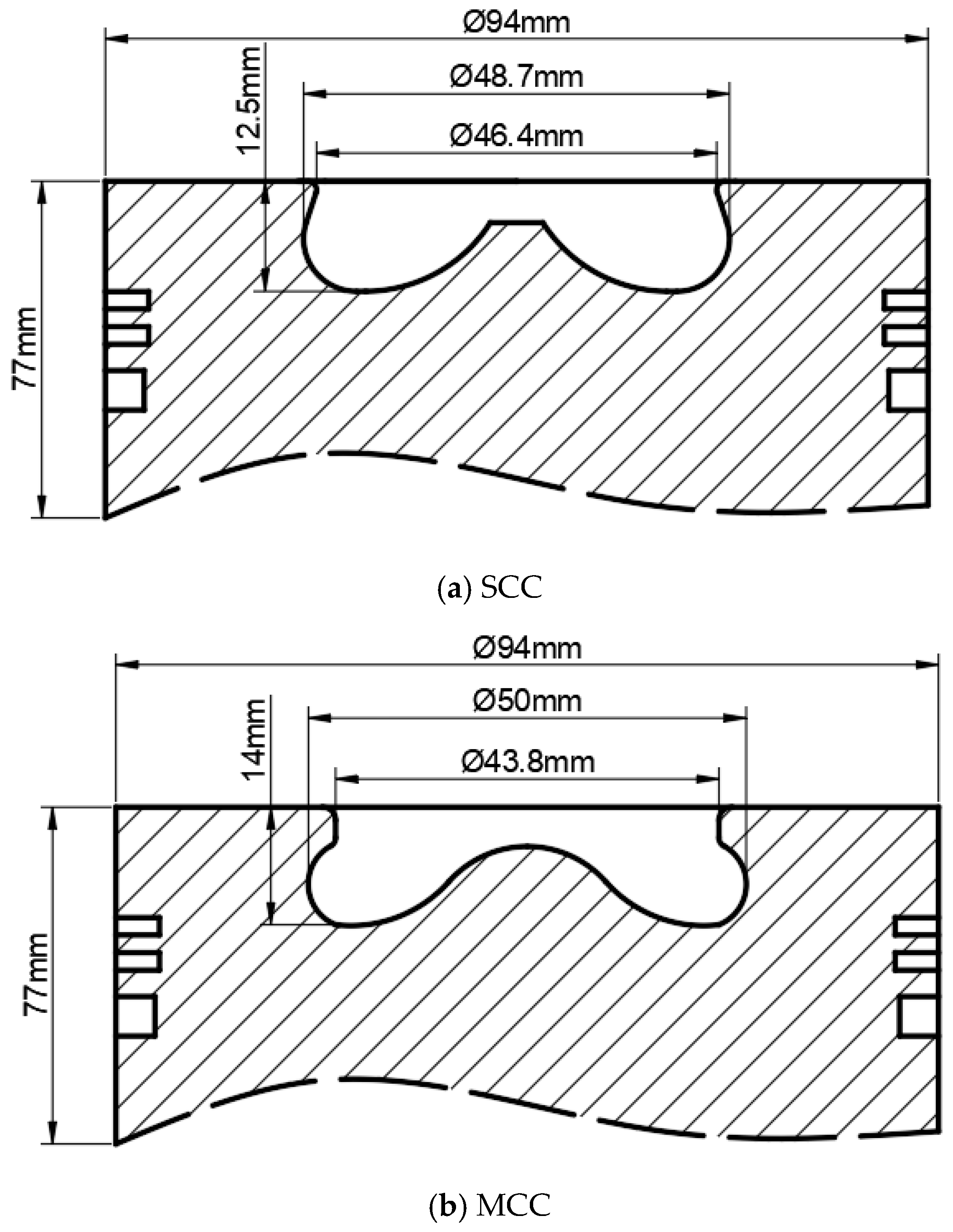
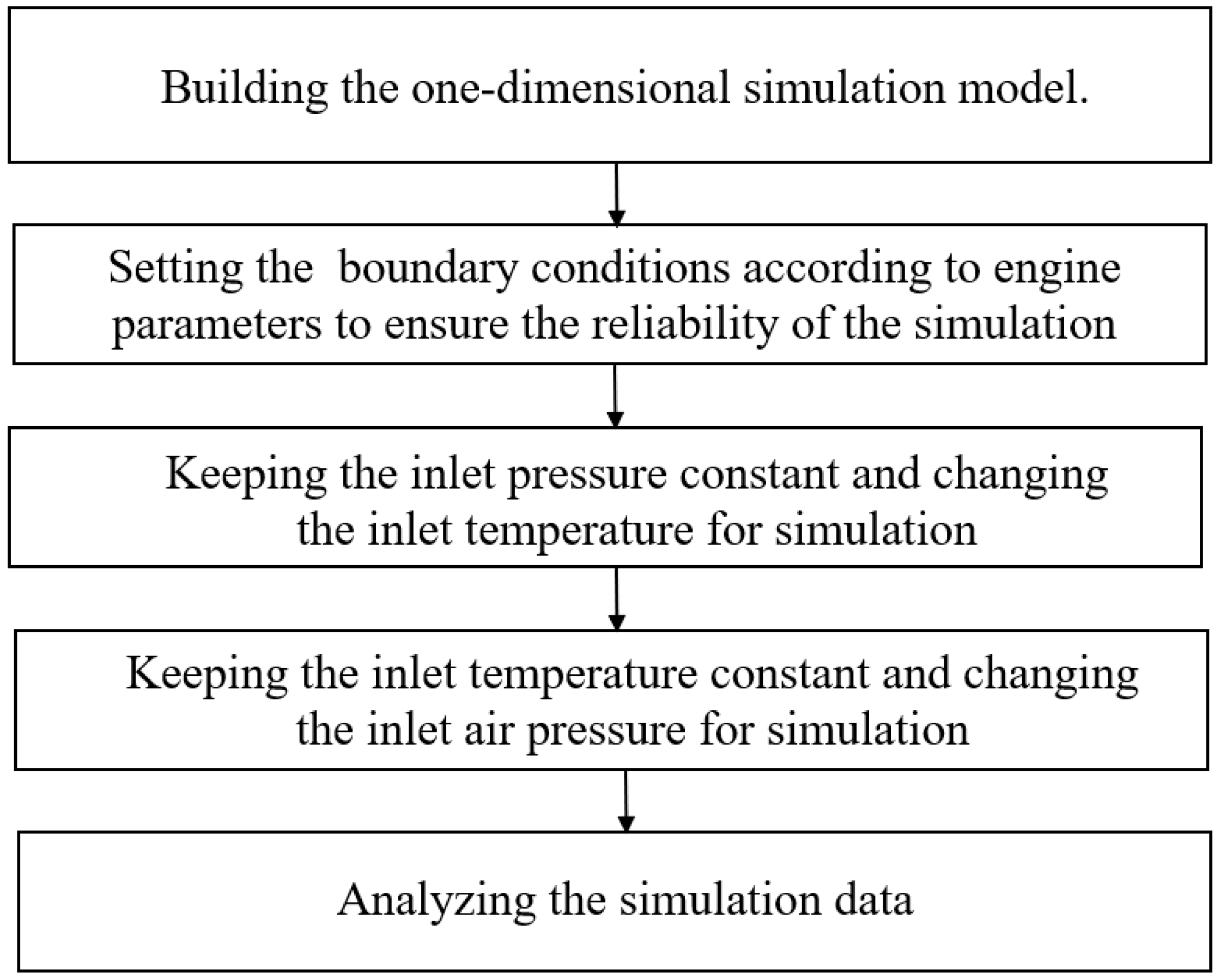


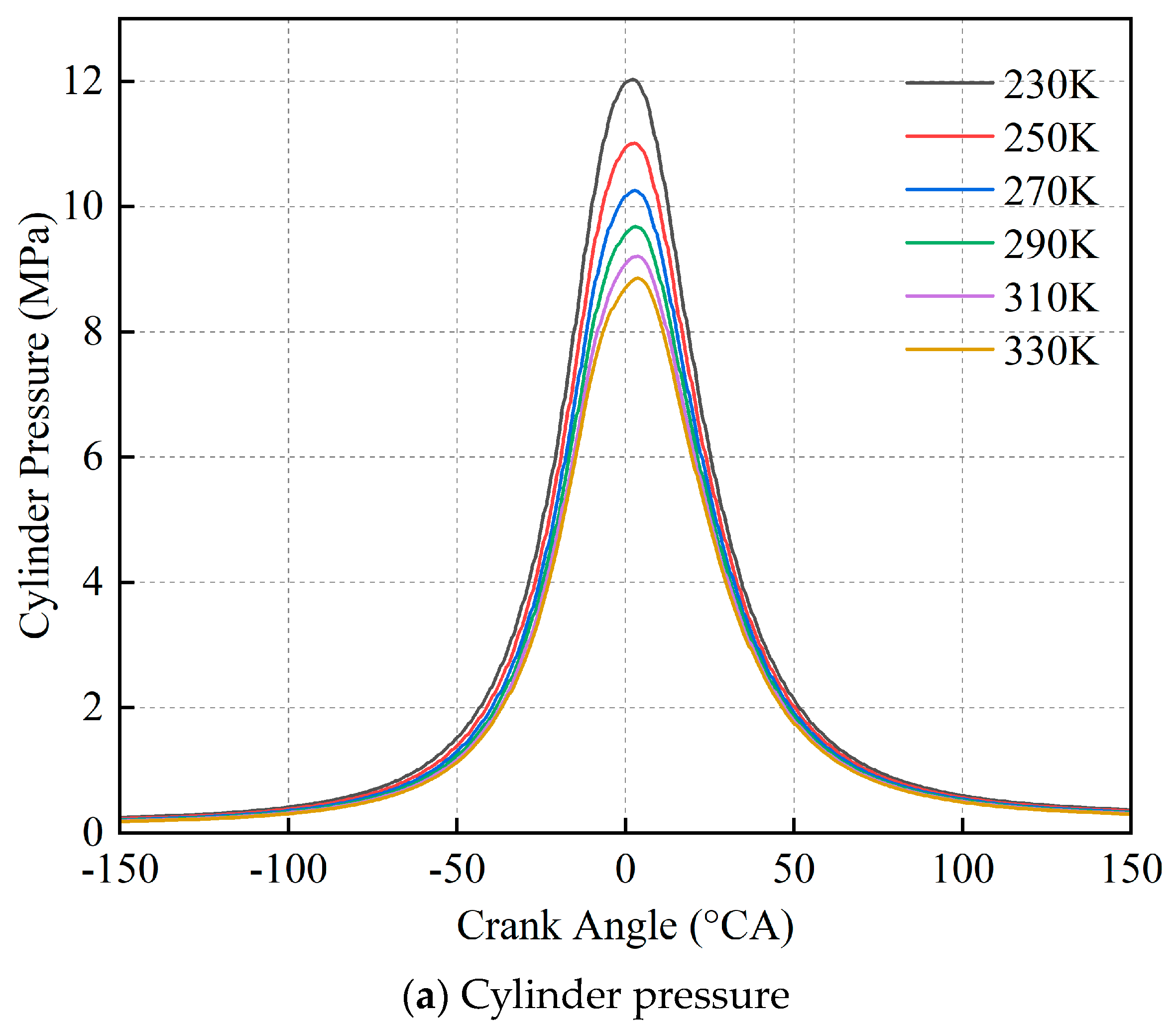


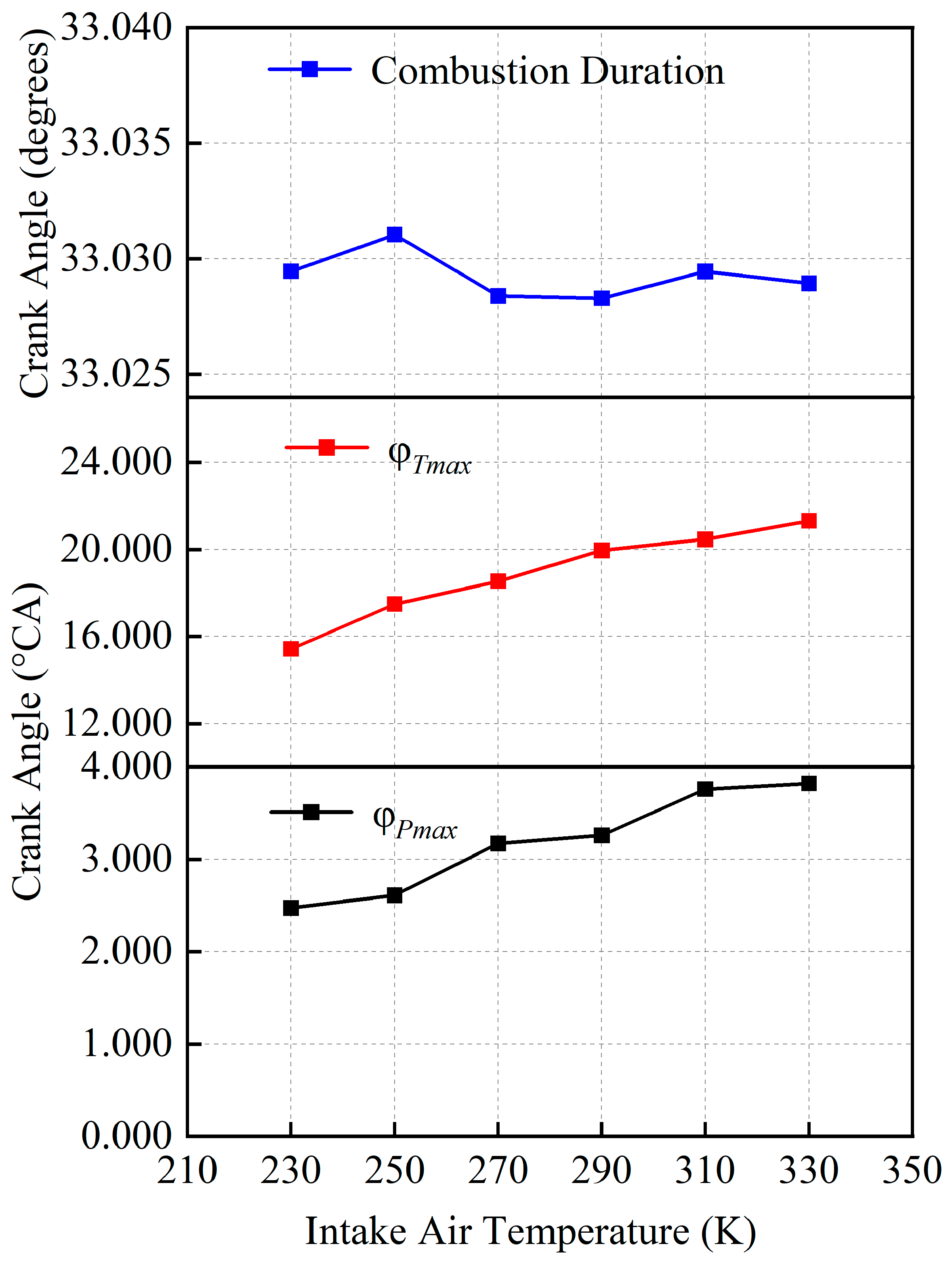
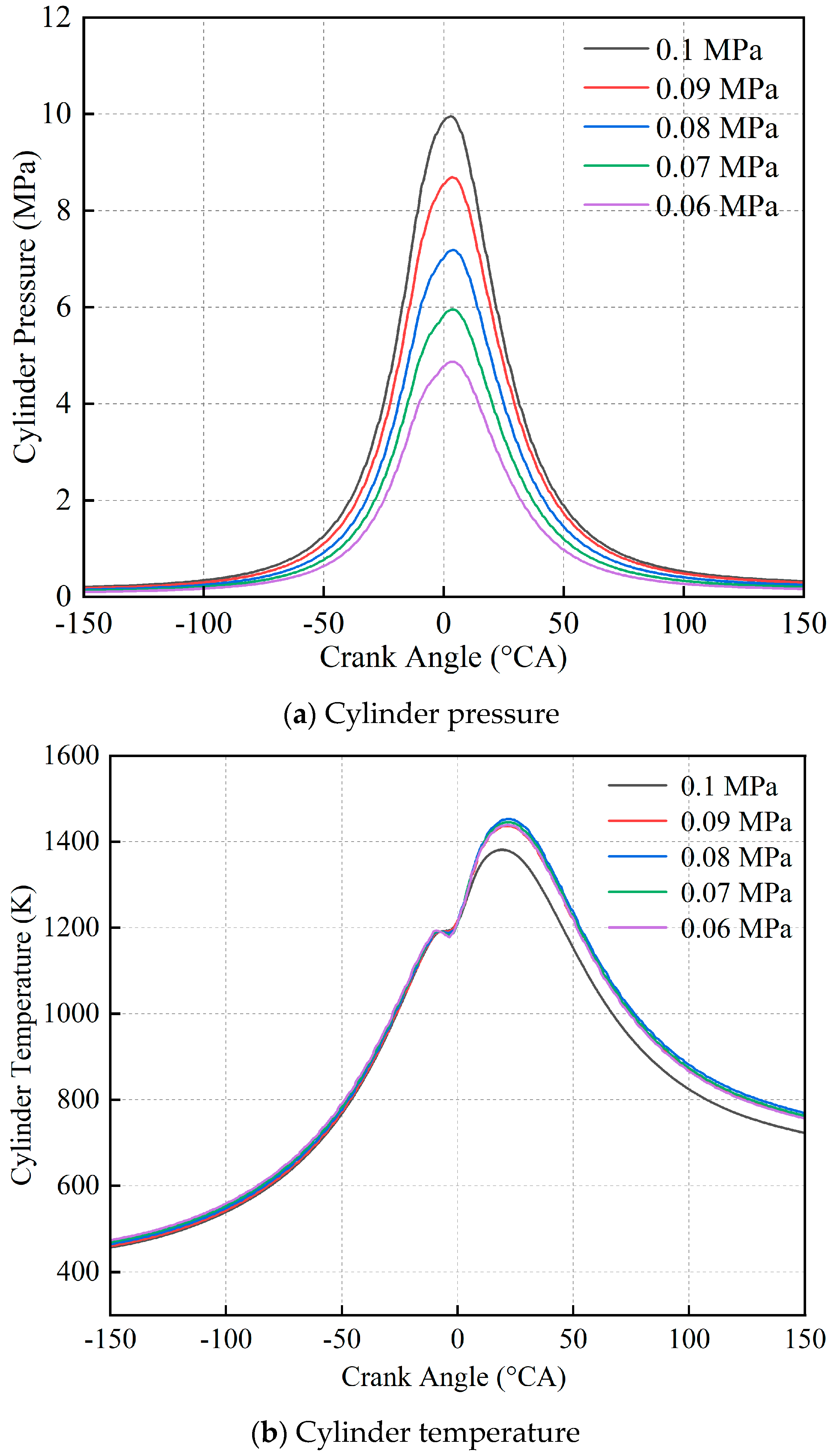
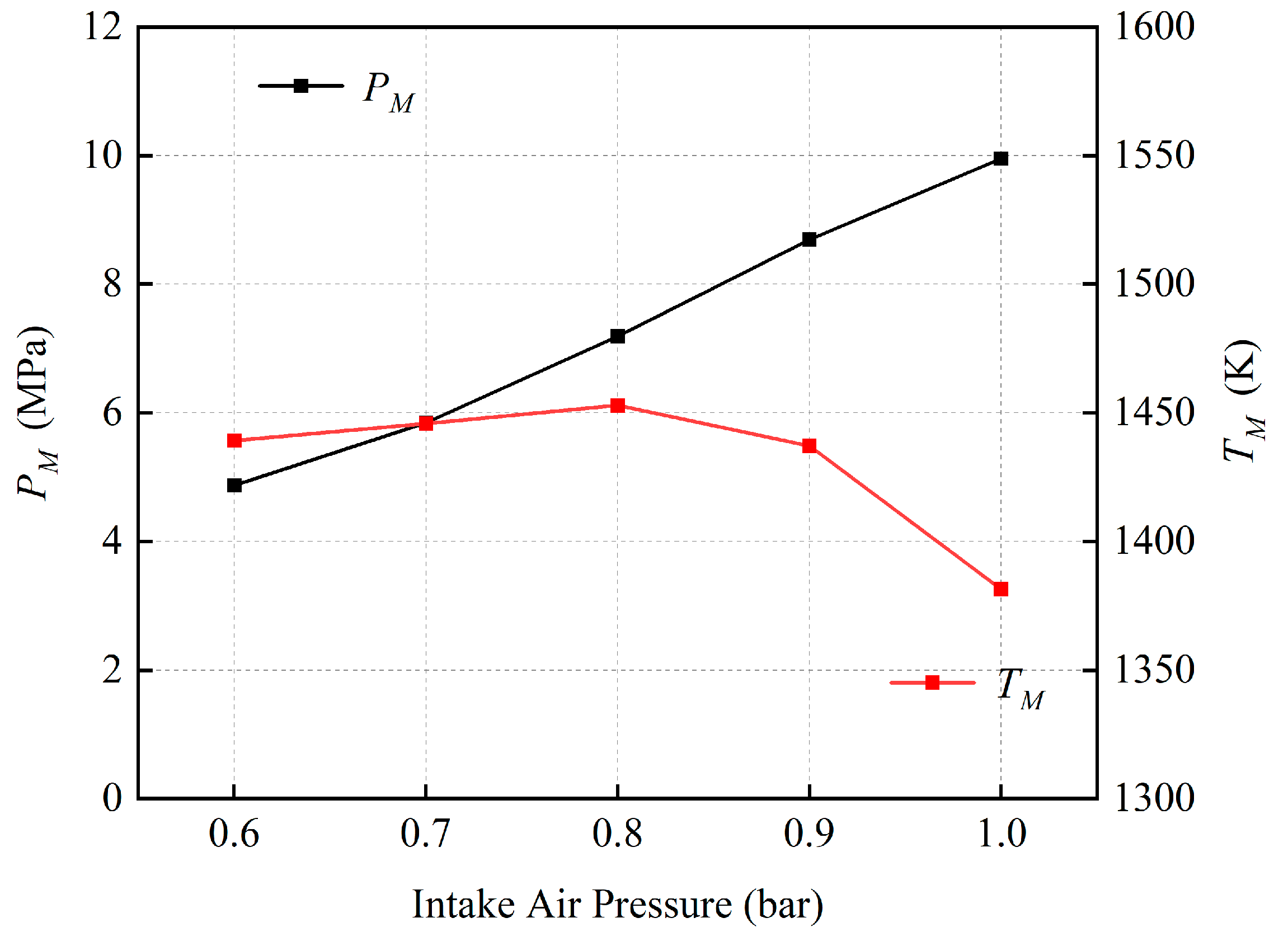
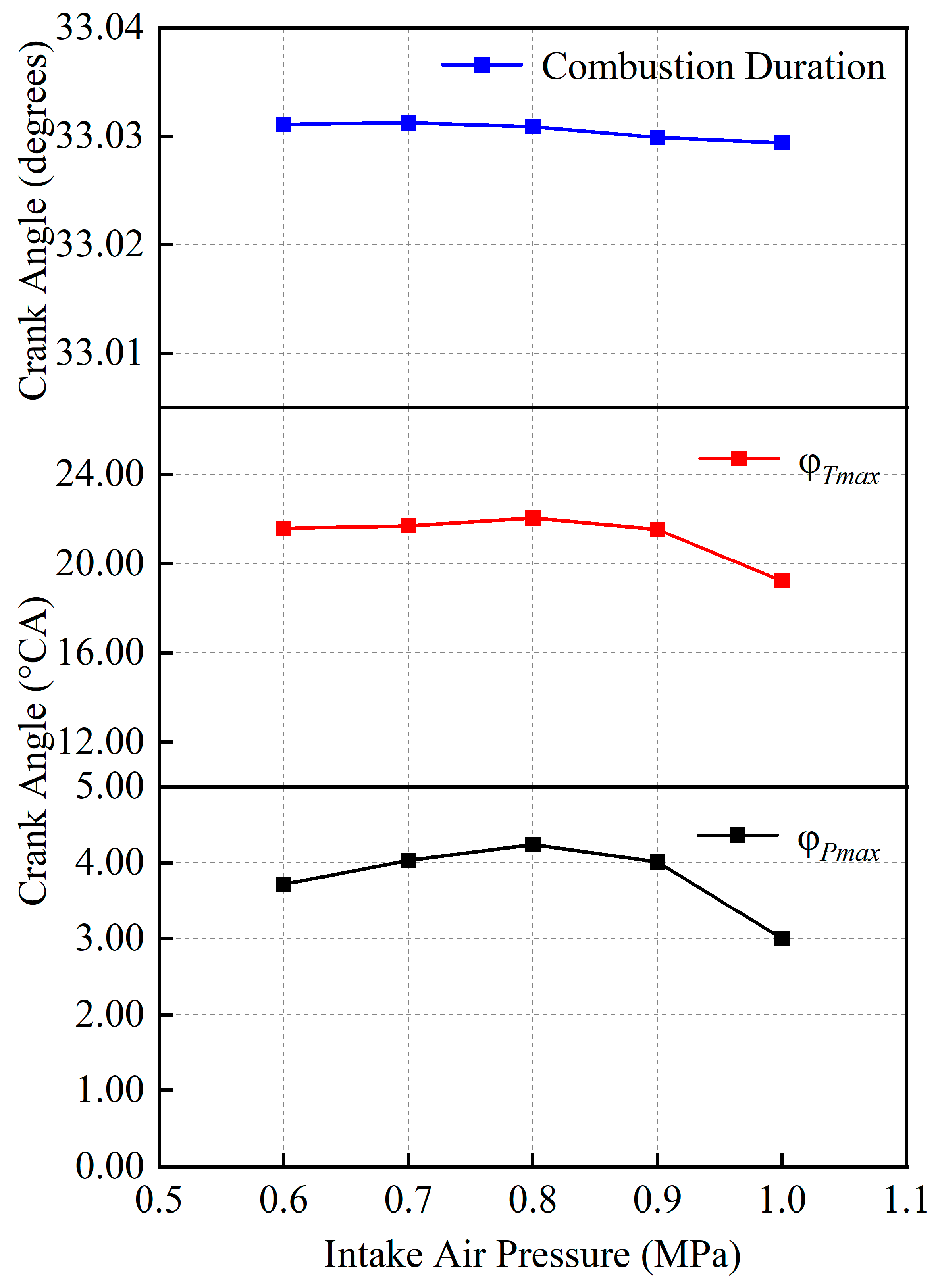

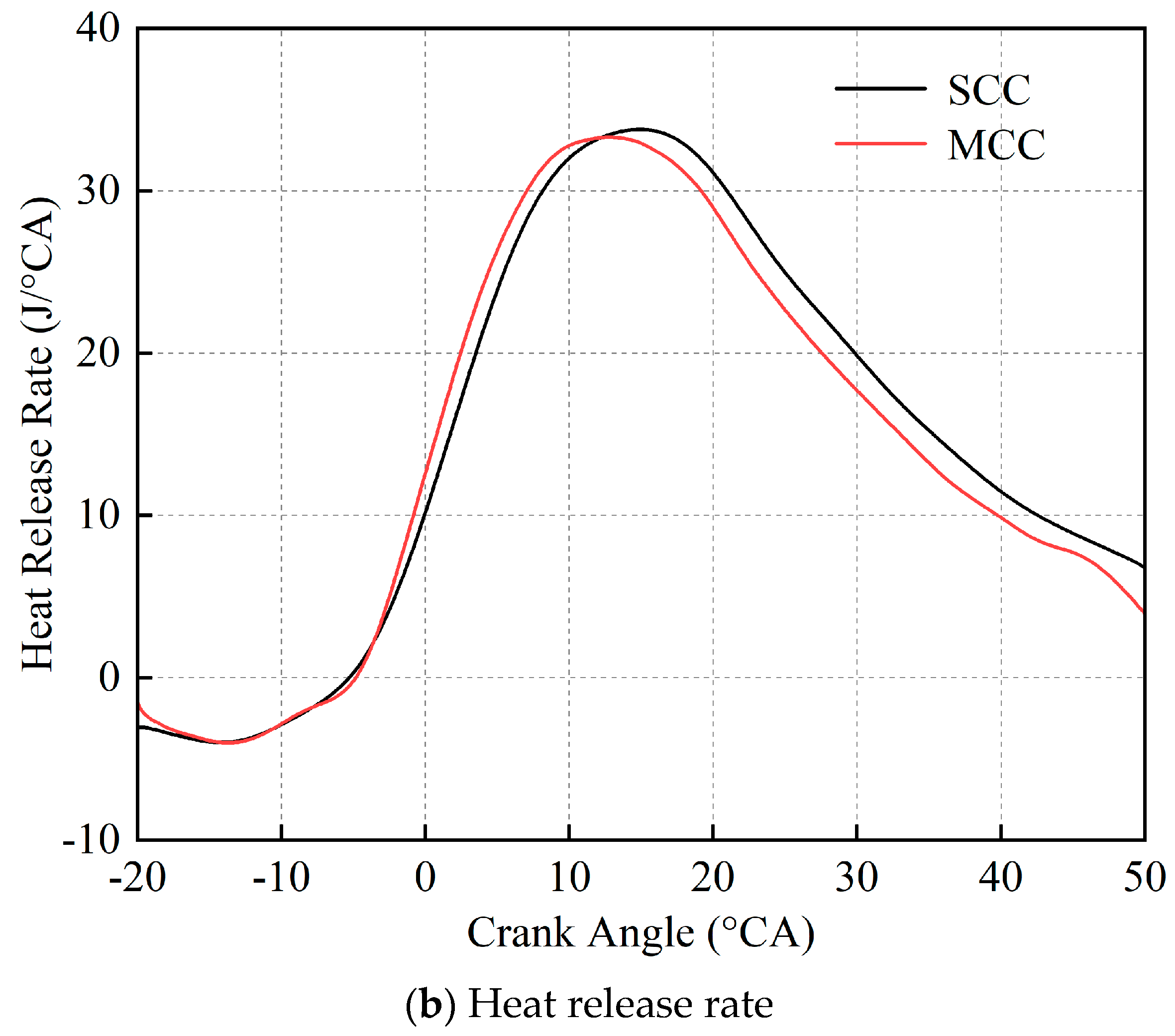


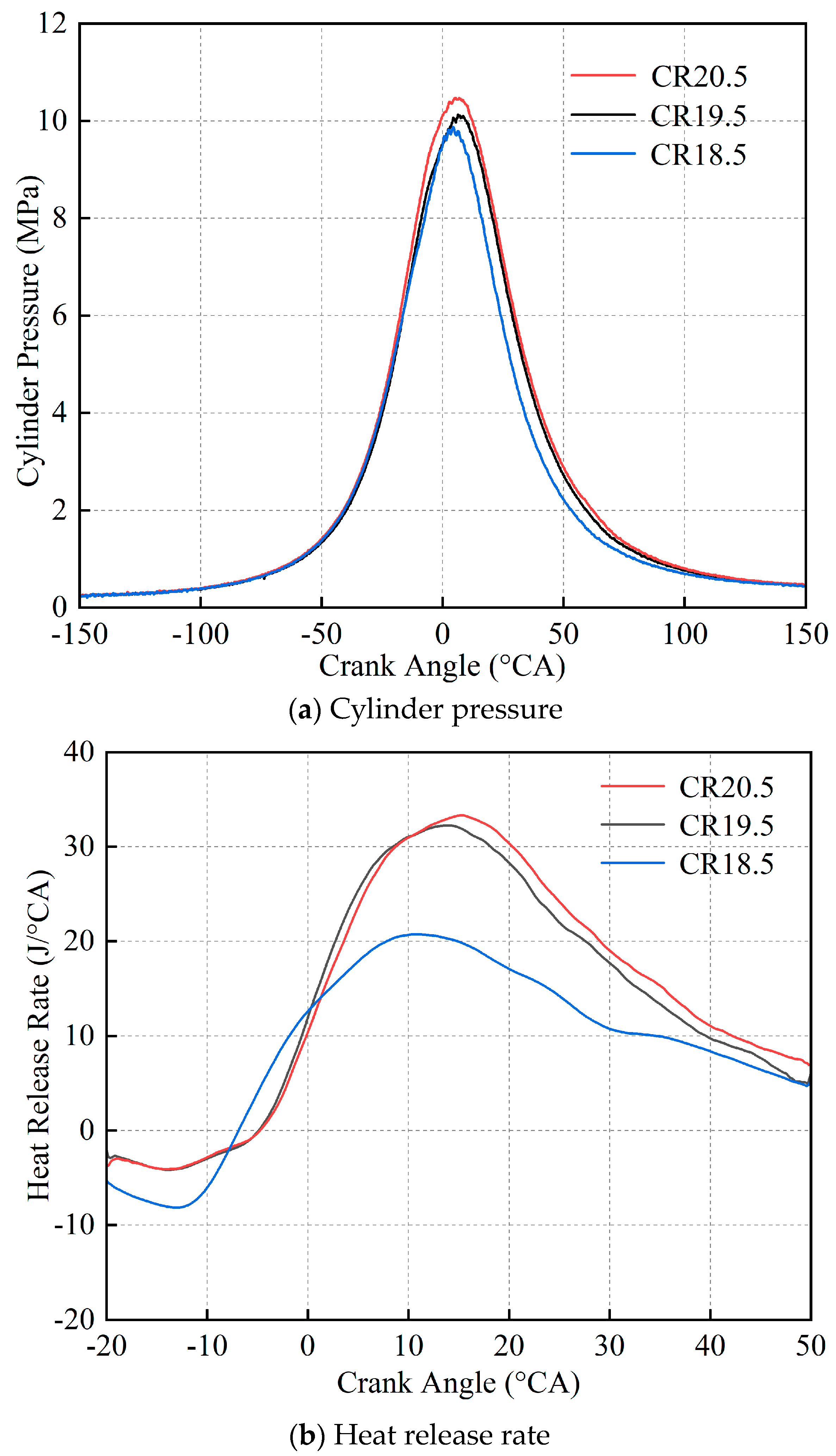
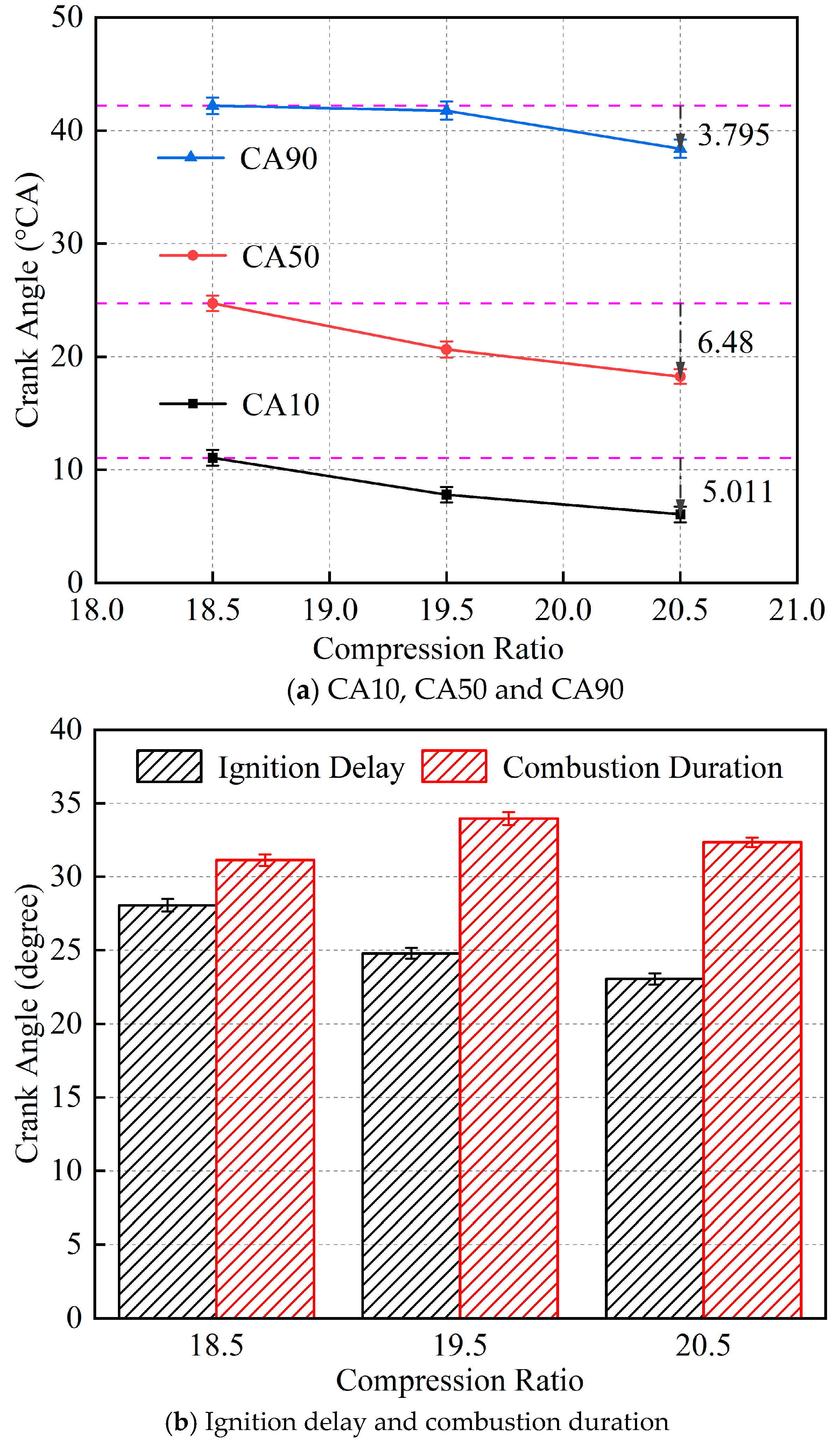
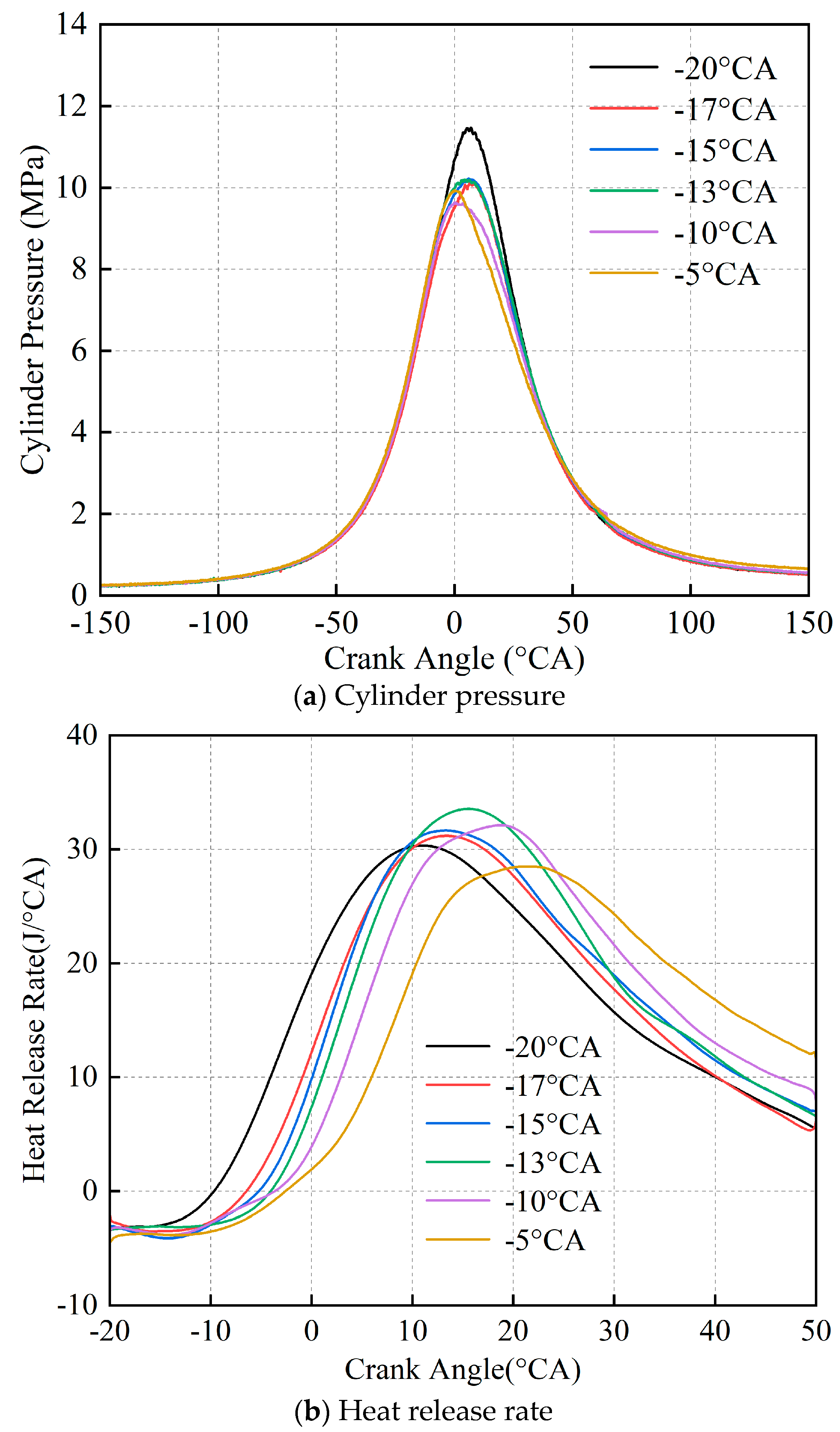
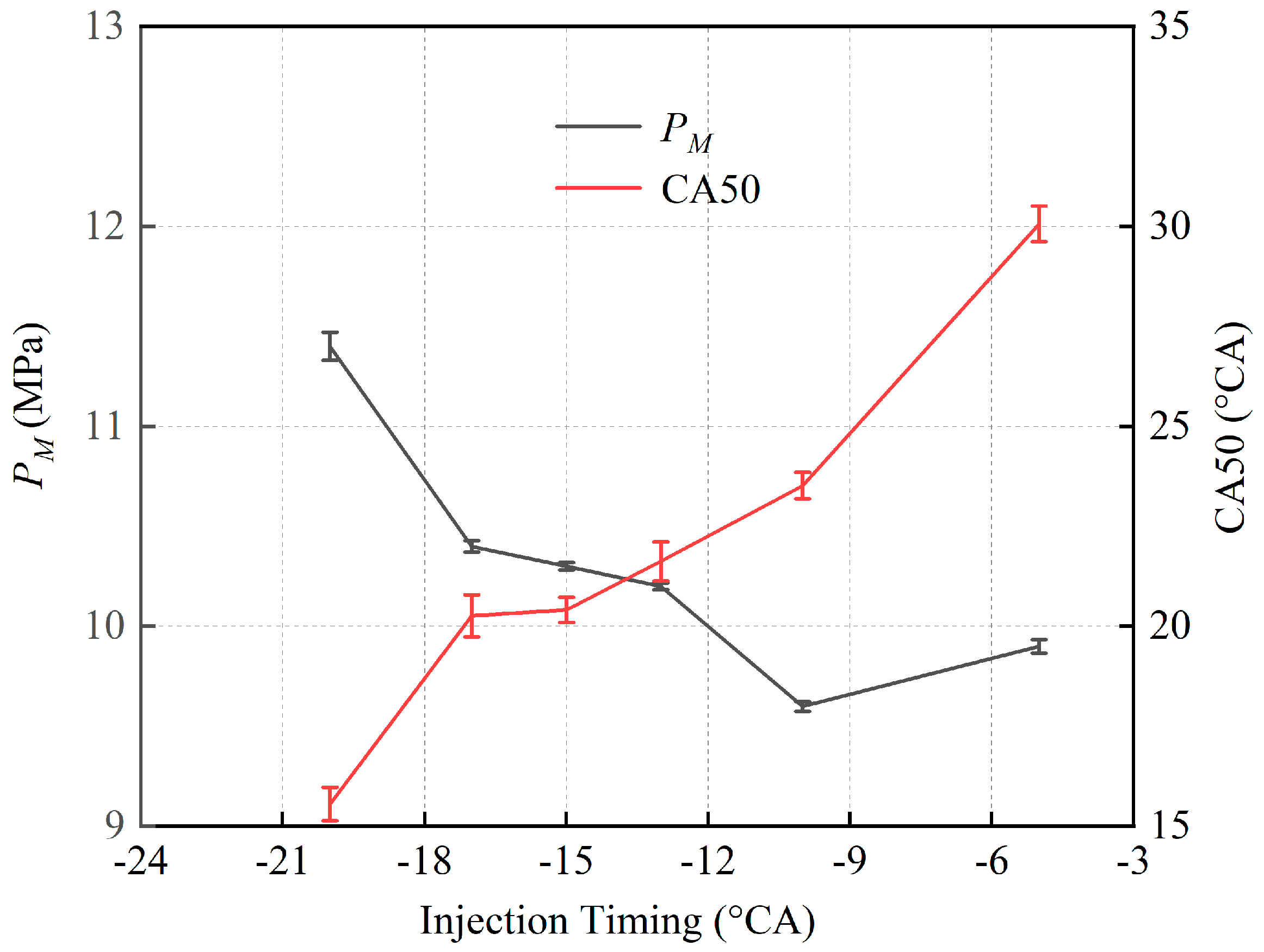


| Brand/Model | Value |
|---|---|
| Type | In-line, turbocharged |
| Number of cylinders | 2 |
| Bore Stroke (mm) | 94 × 77 |
| Displacement (L) | 1.069 |
| Compression ratio | 18.5 |
| Rated revolution (rpm) | 3000 |
| Rated power (kW) | 14 |
| Maximum power (kW) | 15 |
| Compression clearance height (mm) | 1.2 |
| Fuel supply mode | Pump-tube-nozzle |
| Sensors/Instrumentations | Model | Uncertainties |
|---|---|---|
| Oil consumption meter | FN-03 | ±1% |
| Temperature sensor | WRNK191 | ±1% |
| Combustion analyzer | CA3004A21 | ±0.5%FS |
| Cylinder pressure sensor | Kistler-6050A | ±0.3% |
| Speed sensor | M16 × 1.5 | ±1 rpm |
| Oil pressure gauge | WHM5 | ±2% |
| Hygrometer | SH002 | ±1% |
| Dynamometer | WY-AC-16 | ±0.1 kW |
| Serial Number | Engine Speed | Percent of Engine Load |
|---|---|---|
| 1 | 3000 rpm | 100 |
| 2 | 3000 rpm | 75 |
| 3 | 3000 rpm | 50 |
| 4 | 3000 rpm | 25 |
| 5 | 3000 rpm | 0 |
| Boundary Conditions | Range |
|---|---|
| Fuel temperature (K) | 303 ± 5 |
| Ambient temperature (K) | 298 ± 5 |
| Pressure difference before and after intercooler (MPa) | <0.002 |
| Exhaust back pressure (MPa) | <0.006 |
| Exhaust temperature before turbine (K) | <823 |
Disclaimer/Publisher’s Note: The statements, opinions and data contained in all publications are solely those of the individual author(s) and contributor(s) and not of MDPI and/or the editor(s). MDPI and/or the editor(s) disclaim responsibility for any injury to people or property resulting from any ideas, methods, instructions or products referred to in the content. |
© 2024 by the authors. Licensee MDPI, Basel, Switzerland. This article is an open access article distributed under the terms and conditions of the Creative Commons Attribution (CC BY) license (https://creativecommons.org/licenses/by/4.0/).
Share and Cite
Yao, X.; Dong, Y.; Li, X.; Ni, P.; Zhang, X.; Fan, Y. Exploring the Combustion Performance of a Non-Road Air-Cooled Two-Cylinder Turbocharged Diesel Engine. Sustainability 2024, 16, 6031. https://doi.org/10.3390/su16146031
Yao X, Dong Y, Li X, Ni P, Zhang X, Fan Y. Exploring the Combustion Performance of a Non-Road Air-Cooled Two-Cylinder Turbocharged Diesel Engine. Sustainability. 2024; 16(14):6031. https://doi.org/10.3390/su16146031
Chicago/Turabian StyleYao, Xingtian, Yunxiao Dong, Xiang Li, Peiyong Ni, Xuewen Zhang, and Yuhang Fan. 2024. "Exploring the Combustion Performance of a Non-Road Air-Cooled Two-Cylinder Turbocharged Diesel Engine" Sustainability 16, no. 14: 6031. https://doi.org/10.3390/su16146031






